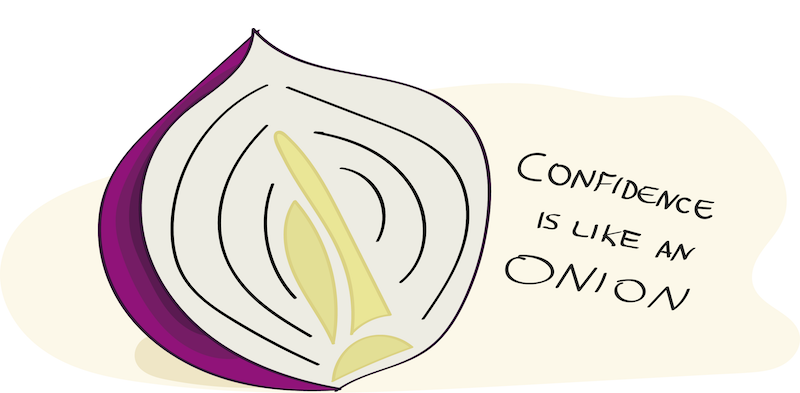The Confidence Onion: The Truth About Spanish Speaking Confidence

Get our free email course, Shortcut to Conversational.
Have conversations faster, understand people when they speak fast, and other tested tips to learn faster.
More infoAll the time, I get questions about confidence.
“I studied it high school and remember a lot but don’t really feel confident using it with real people, how do I overcome this?” – Jason
“My family is all latin and I’m the only one who can’t speak Spanish, and when they all start talking fast together I get lost and shut down. I don’t want to get embarrassed.” – Alejandra
“I feel like I know a ton of Spanish but when I actually come face to face with a real speaker I just freeze.” – Patrick
Does this sound like you? Probably.
I ran a poll of 672 people learning Spanish recently, and 41% of them said that their biggest challenge with Spanish was Confidence (the other big one, 46%, was understanding people when they speak fast, which is closely tied to confidence).
So if you’re struggling with confidence when speaking Spanish, you’re not alone.
Today, I’m going to share with you the truth about confidence – not just when it comes to learning Spanish, but for anything. It’s how I managed to have high confidence speaking so fast, and it’s the strategy that’s helped hundreds of people like you.
What is Confidence?
Before we get into how to improve your confidence speaking Spanish, we need to get straight on what confidence actually is – because so many people get mixed up on this. The reality is, evolutionary psychology knows very well at this stage what confidence really is. My favorite definition is by PhD Geoffrey Miller:
“Confidence is the realistic expectation you have of being successful at something, given (a) your competence at it and (b) the risk involved with doing it.”
A great example he uses is that of driving a car. When you first start learning to drive, you have (a) no competence at it, and (b) high risk, as driving a several ton machine at high speeds, while navigating roads and other cars, is dangerous.
Your feeling of low confidence is an evolutionary mechanism to keep you alive. If you felt high confidence and didn’t know what you were doing, you could very quickly kill yourself.
But after years of driving, you’ve done it so much that you have high competency, and the risk involved is decreased because you’ve had so much experience in all types of sitations.
The Confidence Onion
It’s the same thing with learning Spanish.
Confidence is not an on/off switch – it’s not something you have or don’t have.
No, confidence is like an onion.
When you first start learning, you have no confidence in anything. But after a short period of time, you’re pretty confident at greetings – because you’ve done them a lot, and you’re not worried at that point that you won’t be able to say “hola, como estas?”. That gives you the most inner layer of the onion.
As you learn more, and then practice those concepts, eventually you are confident at those things, and your onion of confidence adds layers. Pretty soon you’re confident ordering food at a restaurant and giving directions to a taxi driver. Then you’re confident at basic conversations.
As you learn, the sphere of things you are confident speaking about increases, adding layers to the onion. Pretty soon, you are confident having normal conversations, just like you’d have in English. But even at that point, you aren’t confident speaking about philosophy or science – because you don’t have much competence there.
In this way, just as you build from communication to perfection, you build from confidence in greetings to confidence in conversations to confidence speaking about advanced topics or using advanced grammar. It’s not black and white.
The nice thing is, as your onion grows, your confidence that you will be able to add more layers to the onion goes up too. Once you can have conversations confidently, you’ll carry more confidence into learning new things or handling unfamiliar situations, as you have a history of – a demonstrated competence in – learning new things and handling somewhat unfamiliar situations before. Your confidence snowballs.
So the strategy here is to add new concepts, practice them to become confident, and then add more concepts and repeat the cycle. In this way, if you are within the sphere of your ever-expanding confidence onion, you’ll never feel nervous or worry about making embarrasing mistakes. This is because you’ll have handled those situations many times before and since the first 51 times went fine, you have no reason to worry about the 52nd time.
How to Apply This
So now you understand the strategy and how confidence works. How do you actually go use it now?
The reality is that to get to a conversational level, there aren’t THAT many grammar or concepts to understand in Spanish. It’s not a small amount, but compared to every concept and conjugation you could possibly learn, it’s a small sliver that can be learned intellectually fairly rapidly.
The tricky thing is that just understanding these concepts is where you’re probably at now. Understanding at a intellectual level doesn’t help you when it comes time to open your mouth and talk to a real person. It doesn’t help with your confidence.
The only solution for that is practice. Practice speaking with a real person. This is a recurring theme you will see come up here in this blog over and over, because it is so fundamentally true that you can’t ignore it – you can learn grammar, concepts, vocab, pronunciation, etc. intellectually using apps, books, written practice, videos, or educational blog posts like you find here, but at the end of the day, if you want to actually be able to USE it in REAL conversations, you have to practice using it a LOT in real one-on-one conversations with native speakers. There’s no getting around it.
So fundamentally, you should learn a new concept, and then spend time in conversational practice to make it come naturally. If you take the most valuable, flexible grammar (what we teach first) and have it down cold from tons of practice using it in real speech, your confidence and conversational ability will be much higher than if you “know” twice as much grammar but haven’t practiced it over and over.
Of course, BaseLang is the best and most cost-effective way to do this, at just $179/mo for unlimited classes (key for getting in lots of speaking), but whether you use us or not, if you want to improve your confidence, you need to be speaking. At the end of the day I care that you are speaking more than if you use us to do it or not.


